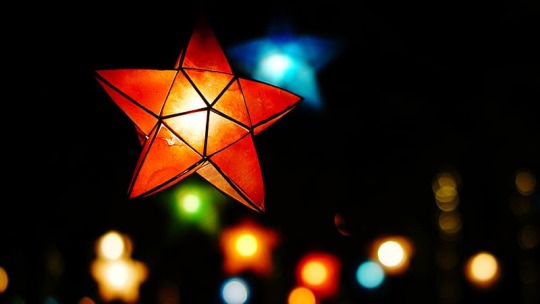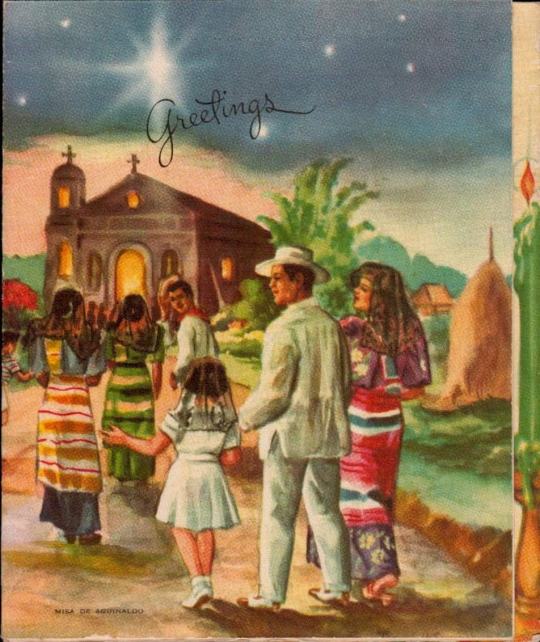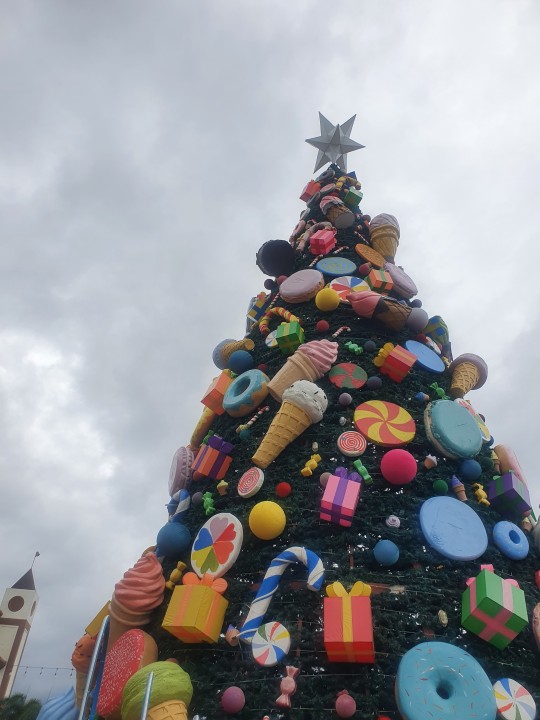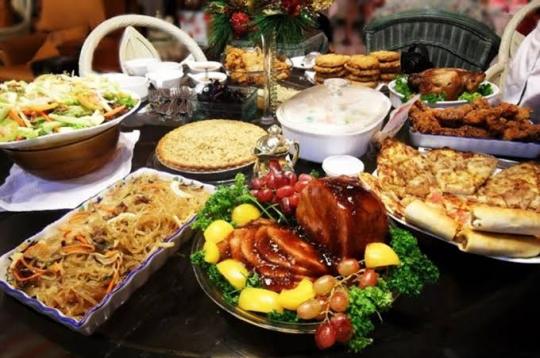#philippine christmas
Text
Simbang Gabi: The 9 Days Before Christmas

An image of a red parol from Peakpx.com
The Philippines is well-known for its extremely long Christmas celebration that a lot of foreigners often look at with confusion. Traditionally, Filipinos may start putting up their trees, playing festive songs, and counting down to the 25th as early as September in a season that's colloquially called the "ber months" or the "ber months season" (Petrelli, 2021). This period often lasts up until January or February where some houses may still keep their trees and decor pushing as far as March.
Even with this technicality, however, you'd be hard-pressed to find Filipinos truly celebrating from the very beginning of September genuinely ending it by the end of February. Most often, actual celebrations start after Undas, a period encompassing All Saints' Day and All Souls' Day on the 1st and 2nd of November respectively to commemorate the dead, similar but a lot more subtle than other Catholic countries own Day of the Dead like in Mexico's Dia de Los Muertos and Italy's Giorno dei Morti. This time period is often the start of people doing more Christmas-y things such as Kris Kringle activities leading up to the main Christmas party.
The main markers of the true start in itself is the Advent season, which starts on the Sunday nearest to the 30th in Western Churches like Roman Catholicism and leads up to Christmas ("Advent", n.d.). This is where Catholics would go to Church every Sunday leading up to Christmas to light the Advent Wreath until the final candle on its center on Christmas day on the 25th. As the Philippines is heavily influenced by Roman Catholicism, Filipinos follow the Western start of Advent and most celebrations often fall in the middle of this time period. Even the middle of Advent, however, Filipinos have a waiting period to count down before Christmas - Simbang Gabi.
What is Simbang Gabi?
Simbang Gabi (en. night mass; going to mass at night) is a Philippine Christmas tradition wherein Roman Catholic Filipinos would attend mass nine days every single morning or night before the actual Christmas celebration. Traditionally, the masses were held every morning at 4:00 AM from the 16th to the 24th which would then be capped off by Christmas Eve Mass at night or Christmas Mass on the 25th with its early schedule earning it the name Misa de Gallo (en. mass of the rooster) (Lazaro, 2020). In most dioceses, however, they often have an anticipated mass schedule that start a night earlier than the morning masses (Hermoso, 2022).
Besides being called Misa de Gallo, I had also heard the celebration being called Misa de Aguinaldo (en. mass of gifts) in some places. This shares the same name as the similar Puerto Rican tradition Misa de Aguinaldo which is also a nine-day mass held in the morning, typically at 5:00 AM which is also deeply-rooted in Puerto Rican Christmas traditions (Álvarez, 2018).
History

A vintage greeting card posted by the Facebook group Vintage Philippine Islands 1920-1959 (2020)
Being a Christmas tradition, it is not surprising that Simbang Gabi could trace itself back to the Spanish colonial period.
A common misconception of its origins states that the practice first started in Mexico. Hermoso (2018) states that it started on the year 1587 by Friar Diego de Soria of the Convent of San Agustin Acolman when he requested the Vatican to allow church service to be held outdoors because of an overflow of attendees during the Christmas time. Pope Sixtus V later approved of this request and even decreed that these kinds of masses be held in the Philippines at the dawn of the 16th of December. What this doesn't account for was that the practice of going to church for the Eve of Christmas dates back to even earlier than the 16th century.

The cover for an English translation and compilation of Etheria's writings by M.L. McClure and C.L. Feltoe, D.D. (1919)
The first recorded instance of Christians celebrating Christmas by going to early mass leading up to the actual date was first written by Egeria (also called Egeriae, Etheria, or Aetheria), a Christian Galician woman who first recorded it during her travels to the Levant where she notes the early morning masses and festivities from the time of the Epiphany to the Nativity. She writes in her letters later called the Itinerarium Egeriae (en. The Travel Guide of Egeria; The Pilgrimage of Etheria).
"Octave of the Festival.
On the second day also they proceed in like manner to the church in Golgotha, and also on the third day; thus the feast is celebrated with all this joyfulness for three days up to the sixth hour in the church built by Constantine (...) And in Bethlehem also throughout the entire eight days the feast is celebrated with similar festal array and joyfulness daily by the priests and by all the clergy there, and by the monks who are appointed in that place (...) and immense crowds, not of monks only, but also of the laity, both men and women, flock together to Jerusalem from every quarter for the solemn and joyous observance of that day."
- Egeria, 381-384; The Pilgrimage of Etheria (trans. McClure & Feltoe, 1919):
The practice of attending early morning masses up until the main festivities of the Nativity was later adopted by more Western Christian communties during the time of Pope Sixtus III when he celebrated what is widely considered the first Midnight Mass at the Basilica of St. Mary Major in Rome, not only stemming from the popularity of the Christians from Jerusalem but also the popular belief that Jesus was born at midnight (The Pillar, 2021).
The prayer spoken within the midnight vigil was then called the "mox ut gallus cantaverit" which translates to "when the rooster crows", aptly named because of the early hours the vigil tended to last which then coincided with the crowing of roosters ("Misa del Gallo: origen, historia y por qué se celebra en la madrugada del 25 de diciembre", 2022). The practice was continued by the Spanish with the name Misa de Gallo (also called Misa de Aguinaldo)which later spread throughout the Spanish Empire and could now be seen practiced in countries like Bolivia, Puerto Rico, Venezuela, and of course the Philippines.
There seem to be two variations of this: the nine-day series of masses before Christmas (found in the Philippines, Puerto Rico, and Venezuela) and the single early morning mass before Christmas day (found in Spain and Bolivia). It isn't clear if Spain and Bolivia simply dropped the nine-day tradition or if the nine-day tradition was restarted in these other colonies, however.
In the Present Day

An image of crowds outside a church during Simbang Gabi uploaded to Wikimedia by Erwin Malicdem
Today, the Simbang Gabi continues to be a popular tradtion for most Filipino Roman Catholics, even those who aren't typically as religious most parts of the year. This is given the fact that a popular belief is that when a person completes all of the nine days, they may receive a wish to whatever they desire. This is such a common belief that Bishop Broderick Pabillo, a Manila auxiliary bishop, had to remind people that the point of the tradition is to remember Jesus and his nativity (Punay, 2016). Besides this, it is also a common challenge among Filipinos to try to complete it as is or see how many days out of the nine could they actually attend.
It is not uncommon for churches these days to hold an "anticipated" mass the night before the actual date starting instead on the 15th and ending on the 24th with a Christmas mass, instead of starting on the 16th and ending on the 25th. This newer tradition had come from the reign of Filipino dictator President Ferdinand Marcos Sr. during the Martial Law years in the 70s, when Filipinos were not allowed to go out after a curfew until 4 in the morning (Macairan, 2023). This allowed more people and especially those who may not be able to start their day early or those who may have other obligations in the morning to attend masses at night time, typically at around 6 PM - 8 PM.
The only large controversy that I could remember about Simbang Gabi was back in 2011 when the event was banned from being conducted within the Philippine Center in New York City. The ban came about because of it supposedly violated Canon Law which prohibits religious worship in unconsecrated ground or in other words places that aren't seen as places of worship. In an article by Adarlo & Pastor (2014), Rev. Dr. Joseph G. Marabe, the at-the-time head of the Chapel of San Lorenzo Ruiz and a priest-in-residence at St. Patrick's Cathedral where the ban took place, explains in an interview with news site The FilAm:
"It’s not allowed by law to have Holy Mass in an unconsecrated place. Worship should take place in a sacred place. That was an explanation but not a decision. The Archdiocese decides."
- Rev. Dr. Joseph G. Marabe, head of the Chapel of San Lorenzo Ruiz in Chinatown, New York (2011)
The ban was later lifted on 2014 after community leader Loida Nicolas Lewis wrote a letter to the diocese to reconsider the ban which led to the return of the almost 30-year-old tradition that year (Balitang America, ABS-CBN North America Bureau, 2014).
Besides being a huge part of current traditions, a lot of Filipinos, and especially Filipino youth, use the event as an excuse to go out during the night to hang out with friends and even go on dates with their partners. It is not an uncommon sight to see a group of teenagers, often wearing maybe less than typical church clothes, by the edge of the Church seemingly attending mass. Whether or not they're actually being attentive is hard to decipher. Either way, this has led to an explosion of memes almost every year just mocking these kinds of people or making fun of their own.

A screenshot of the "Simbang gabi starter pack" posted by user rhapido on 9Gag.com (2022)
Earlier versions of this meme could be seen posted throughout Filipino social media during the early 2010s

A meme posted by the Facebook page FEU Memes (2012)
The barkada (en. friend group) going to Simbang Gabi had been an older tradition that has found a lot more popularity in the contemporary era because of social media. My mother had told me that she used to use it as an excuse herself back in the 80s to hang out with her friends at night time. This may be a continued past time for especially younger people for years to come.
There's also many street foods associated with Simbang Gabi that may not be unique to the event itself but are nevertheless heavily associated with the event due to their widespread sale during this time period. Foods like bibingka, puto bumbong, kutsinta, and other popular rice cakes dominate the scene which definitely satisfy the hungry parishioners who had, most likely, not eaten breakfast or dinner before going to church. With their strong associations with Simbang Gabii and Filipino Christmas as a whole, I might discuss these on a later date.
Simbang Gabi, from my experience
Growing up and living in the Philippines and especially being raised Catholic within a Catholic town named after a Catholic saint and going to a Catholic school named after another Catholic saint, it probably won't shock you that I, myself, had tried to complete the nine days of Simbang Gabi myself. I had attempted it several times with only maybe trying seriously by myself once in my life. It was quite the experience to just try to dedicate yourself into completing a goal to do something for nine consecutive days straight.
My first attempt was when I was in Junior High and it was with my sister and two people who worked for my parents and had helped watch over us. It was something that I always wanted to try doing and especially since I was gaining a lot more independence at the time so what better to try it out without the rest of the family? With adult supervision, of course.
Since we lived quite away from the actual church, the place was already packed even an hour before the actual mass started. There was barely any seats left and even less standing room leading to a huge overflow of people stuck outdoors, only hearing mass from the outdated speaker system that they had erected in place of the old bell tower.
The mass in our church was often done in the dark during the night out of an deliberate and probably aesthetic choice with only the alter being illuminated by the lights. The rest was lit up by the scattered about Christmas decor throughout the church and the church patio. It always felt like going to some liminal space that other nights at church just doesn't give.
Once the mass has been concluded, people rush out of the doors in thick crowds to find their way into the footpaths leading on to the main town streets. Some opt to stay behind to enjoy the food stalls that had pop-up for the night to eat bibingka, puto, sapin-sapin, and palitaw among other things. Some of the teens had decided to raid the nearby small park and playground as a hang-out spot to talk the night away before they rush home for their curfews. Meanwhile others were just rushing to get home as soon as they can, with people lining up to go to the rudimentary parking space that the church created while the others who didn't own their own vehicles forced to compete for the very few commuter vehicles still riding through the night, hunting for passengers.
This was before we had our own car, so we were with the latter crowds of people, trying to peer through the dark streets only illuminated by the scant Christmas lights that still refused to turn off as the night progressed. Every so often, two headlights excite the crowd and a swarm of them start running in anticipation with not care or tact if they would crush children or separate families all to take a seat on the night jeepneys, some the few commutes left after 9.
My sister was an expert in finding her way through it, reaching out to the doors to form a barricade for herself and the rest of us to prevent others from taking our seats before letting herself in. I still think I would've been left behind if it weren't for her doing that out of sheer competitiveness with the crowds.
We settled into our seats and squeezed in tightly to allow other passengers in so we could all go home as soon as we can. It was a tight but otherwise uneventful commute every night with nothing but tired people waiting for their stops and slowly emptying the once packed vehicle. Since we live in the outskirts of the town, we were often the last few and at times, the drivers would transfer us to other jeeps just so they can go home themselves. This had sometimes instead left us to walk the remainder of the way there through unpaved highway sidewalks.
After a few nights of it, I became more and more reluctant to continue because of the frenzy that it had almost every single night and it was extremely inconvenient for my time and the time of those with me. I didn't complete it then and I hadn't seriously tried until 9th Grade, which honestly was more uneventful.
That attempt was mostly my siblings and I staying in Makati City and Taguig City and going to easily traveled to churches that we could walk to by foot, and high-end malls that have annual Simbang Gabi masses for their shoppers, facilitated by the local diocese and the local fancy church. I was able to complete those easily because I was often dragged either by my siblings or my grandmother who used to never miss a day of church when she was still more active.
It was less about the challenge at that point and more of an obligation which isn't a bad thing and honestly is probably closer to how it should be celebrated.
I hadn't gone to Simbang Gabi since 2019 and I don't have any plans to try this year either. Not really because I don't want to necessarily, but specifically because I physically can't. I still think its pretty fun to do and honestly maybe a good excuse to meet with my friends that I haven't seen in a while. Sadly, I just simply cannot do it now nor in the near future.
Maybe one day I could once again go out at those cold December night to meet my friends and maybe eat some bibingka on my way home but I guess I'll just leave every one else to it.
Sources
Introduction
Advent. (n.d.). In Britannica. Retrieved on 13 December 2023, from https://www.britannica.com/topic/Advent
In The Philippines Christmas Eve Includes A Late Night Street Food Feast, Filipino Christmas, HD wallpaper [image]. (n.d.). Peakpx. Retrieved on 15 December 2023, from https://www.peakpx.com/en/hd-wallpaper-desktop-wxdle
Petrelli, M. (2021, December 20). The country that celebrates Christmas for more than 4 months a year. CNBC. Retrieved on 13 December 2023, from https://www.cnbc.com/2021/12/21/philippines-the-longest-christmas-celebrations-in-the-world-.html
What is Simbang Gabi?
Álvarez, F. (2018, November 22). Una tradición matutina la Misa de Aguinaldo. Primera Hora. Retrieved on 13 December 2023, from https://www.primerahora.com/noticias/puerto-rico/notas/una-tradicion-matutina-la-misa-de-aguinaldo/
Hermoso, C. (2022, December 15). 9-day ‘Simbang Gabi’ begins on Dec. 16; anticipated masses to begin tonight. Manila Bulletin. Retrieved on 13 December 2023, from https://mb.com.ph/2022/12/15/9-day-simbang-gabi-begins-on-dec-16-anticipated-masses-to-begin-tonight/
Lazaro, J. (2020, December 11). The Christmas tradition of Simbang Gabi: After five centuries, this Filipino Christmas tradition lives on. U.S. Catholic. Retrieved on 13 December 2023, from https://uscatholic.org/articles/202012/the-christmas-tradition-of-simbang-gabi/
History
Hermoso, C. (2018, December 15). ‘Simbang Gabi’ a manifestation of the Filipinos’ strong faith in God, says bishop. Manila Bulletin. Retrieved on 13 December 2023, from https://mb.com.ph/2018/12/15/simbang-gabi-a-manifestation-of-the-filipinos-strong-faith-in-god-says-bishop/
Etheria (1919). The Pilgrimage of Etheria (McClure, M., & Feltoe, C. Ed. & Trans.). Society for Promoting Christian Knowledge. Retrieved on 13 December 2023, from https://www.ccel.org/m/mcclure/etheria/etheria.htm (Original work published 384 C.E.)
McClure, M., & Feltoe, C. (1919). [An image of the book cover of "The Pilgrimage of Etheria"]. Retrieved on 15 December 2023, from https://www.ccel.org/m/mcclure/etheria/etheria.htm
The Pillar. (2021, December 21). What time is Midnight Mass?. The Pillar. Retrieved on 15 December 2023, from https://www.pillarcatholic.com/p/what-time-is-midnight-mass
Misa del Gallo: origen, historia y por qué se celebra en la madrugada del 25 de diciembre. (2022, December 24). Marca. Retrieved on 15 December 2023, from https://www.marca.com/tiramillas/actualidad/2022/12/24/63a6c106268e3e7c468b45e8.html
Vintage Philippine Islands 1920-1959. (2020, December 25). A Vintage Greeting Card showing Philippine Christmas… Maligayang Pasko from Vintage Philippine Islands 1920-1959 [image]. Facebook. Retrieved 15 December 2023, from https://www.facebook.com/510513375695362/photos/a.1701322009947820/3595821097164559/?type=3
In the Present Day
Adarlo, S., & Pastor, C. (2014, November 3). Fr. Joseph Marabe breaks silence over Simbang Gabi ban (Part 2). The FilAm: A Magazine for Filipino Americans in New York. Retrieved on 15 December 2023, from https://thefilam.net/archives/16127
Balitang America, ABS-CBN North America Bureau. (2014, September 19). Simbang Gabi returns to NYC after a brief ban. ABS-CBN News. Retrieved on 15 December 2023 from https://news.abs-cbn.com/global-filipino/09/19/14/simbang-gabi-returns-nyc-after-brief-ban
FEU Memes. (2012, December 15). eto yung mga madalas ko makita sa gilid ng simbahan e [image]. Retrieved on 15 December 2023 from https://www.facebook.com/PIYUMEMES/photos/a.210778985704527/317211885061236/?type=3
Macaira, E. (2023, December 15). Simbang Gabi: It’s the mass, not the time. Philippine Star. Retrieved on 15 December 2023, from https://www.philstar.com/headlines/2023/12/15/2318980/simbang-gabi-its-mass-not-time
Malicdem, E. (n.d.) The Bamboo Organ Church or the St. Joseph Parish Church of Las Piñas City in the Philippines during "Simbang Gabi" or Night Mass on Christmas eve. Photo was part of Schadow1 Expeditions coverage of Las Piñas during Christmas season. [image]. Retrieved on 15 December 2023 from https://en.wikipedia.org/wiki/Simbang_Gabi#/media/File:Las_Pinas_Church_during_Simbang_Gabi.jpg
Punay, E. (2016, December 19). ‘Simbang Gabi’ won’t grant wishes – Bishop. Philippine Star Global. Retrieved on 15 December 2023, from https://www.philstar.com/headlines/2016/12/19/1654920/simbang-gabi-wont-grant-wishes-bishop
rhapido. (2022, November 30). Simbang gabi starter pack [Screenshot]. 9Gag. Retrieved 15 December 2023, from https://9gag.com/gag/a5Xnzgr
#mayaposts#mayapino#philippines#filipino#history#philippine history#filipino history#christmas#filipino christmas#philippine christmas#simbang gabi#misa de gallo#misa de aguinaldo#long post#very long post#christianity#catholicism#roman catholic#christian history#food mention
21 notes
·
View notes
Text
september 1st
it's already the first day of christmas!!!
#diary#thoughts#tintin's self corner#journal#1st day of christmas#christmas#philippine christmas#Spotify
0 notes
Text
The funny thing about seeing posts about Halloween being the holiday stopping Christmas from being earlier is that in my country (the Philippines) is that we start Christmas in September. Some people don't even remove their decorations. WE CONTINUE CHRISTMAS TIL JANUARY SOMETIMES EVEN. CHRISTMAS SONGS START PLAYING (although not a lot compared to November) UNIRONICALLY DURING SEPTEMBER. WE DON'T EVEN CELEBRATE HALLOWEEN MUCH.
#philippine christmas#ber months#frikin 5 months almost of christmas#im a christmas lover so i dont care its just funny
0 notes
Text
IT'S TIME- 🎄
#ber months#philippine christmas traditions#here we go again-#“whenever i see boys and girls and the boys and girls sees me-”#jose marichan and miriah carey is thawing as we speak#merry christmas 2023#september#my art#Song: “Merry Christmas by Eurodacer”#mj2x#marionettej2x
409 notes
·
View notes
Text

November 29, 2023: Quezon, the Philippines
A vendor works on Christmas star lanterns at a street market
Photograph: Eloisa Lopez/Reuters
108 notes
·
View notes
Text
Merry Christmas and Happy Holidays to all🎉🎄🎅🎁
#transgender#filipina#asian girl#hrt#mtf#transpinay#pinay#pinaybeauty#cute pinay#cute trans#merry xmas#xmas 2023#xmas gift#christmas#merry christmas#philippines#christmas in the philippines#happy holidays#happyholidays
69 notes
·
View notes
Text
Christmas presents ca 1925

Madame d’Ora ~ Ballettänzerin Anna Pavlova, Anna Pawlowa (1881-1931). Porträt in einer Weihnachtspantomime, ca. 1925, Fotografie von d’Ora | src getty images
View on WordPress

Irving Chidnoff ~ Mexican actress of the silent era, Dolores Del Rio (1905 – 1983), with some Christmas presents, ca. 1925. | src getty images
View on WordPress
#anna pavlova#Dora Kallmus#dolores del rio#christmas#christmas presents#dancer#Tänzerin#danseuse#danzatrice#bailarina#Dora Philippine Kallmus#Madame d’Ora#anna pawlowa#irving chidnoff#Atelier d’Ora#portrait#Porträt#retrato#ritratto#1920s#portret#retrat#Bildnis#silent era actress#women artists#women photographers#Weihnacht#weihnachtsgeschenke
38 notes
·
View notes
Text
It's the most wonderful time of the year. 🎵

Nov. 25, 2023 / Quezon City
24 notes
·
View notes
Text
🎄vid
#philippines#selfie#princess#reblog#girl#tumblr#me#love#thoughts#mood#christmasvibes#christmas#alone#vibe#video#tiktok#lip sync#christmaspost#christmasvideo#girly#biebers
22 notes
·
View notes
Text


I initially wanted to release this on Christmas Day. But since I've got plans to celebrate with family, I decided to share it now so I won't be late.
Hope you guys love it. And of course, Merry Christmas & Happy Holidays! ^_^
#Little Witch Academia#LWA#Akko Kagari#Lotte Jansson#Sucy Manbavaran#Jollibee#fried chicken#Philippines#Filipino#Christmas
22 notes
·
View notes
Note
random question inspired by my general disdain for The Holidays™: what's Christmas like in the Philippines? I'm extremely fed up with how most Americans celebrate it so I'd be super interested to hear about how another culture does it. :D (if you don't mind, of course!) Feel free to infodump as much or as little as you like :)))
WAAAAA I'd love to!! Also that's totally understandable OOF, but yes I'd gladly talk about it!!!

So I hope this doesn't come as a disappointment but the Philippines is a pretty Americanized country, but of course there are still many key differences in our traditions! For one, which you might have heard LOL, we start preparing for Christmas all the way in September (as in, Christmas decorations start going up already, and Christmas music starts playing in the malls). Generally we don't celebrate Thanksgiving since it's an American holiday and we don't care as much about Halloween, so it's not like a WHOLE THING like it is in America (I was surprised to learn how big of a deal it is over there LOL!).
We have this celebrity who's also a beloved Filipino meme, Jose Mari Chan, who basically is like, the harbinger of Christmas here. Like months in advance we'll have memes pop up occasionally saying stuff like "Ready na ba kayo?" (are you ready yet??) and things like that LOL. Here's some of my favorite examples:

("I'm just warming up")

(explanation and translation: we have a famous Filipino Christmas song that starts with, "Whenever I see girls and boys selling lanterns on the street...", which is what Jose Mari Chan is starting to sing LOL, then the guard is saying, "Sir, seniors aren't allowed to go out." (this was made during pandemic times HAHAHA)
And a personal favorite:

LOLLL
Also since the majority of the Philippines is Catholic that plays a huge factor in it too. Another tradition that's mainly Catholic (so I haven't ever actually participated in it) is called simbang gabi, which is basically nine days of mass before Christmas. Then on Christmas Eve the final mass is called Misa da Gallo. It's basically a way for everyone to prepare for Christmas!
Another big thing about Philippine Christmases (although I'm sure a bunch of other cultures do this too LOL including Americans), we a lot of the time celebrate Christmas with our extended families (both sides during different times if possible!), since, you know, family is very important to us!! Us younger ones will usually go around to the adults to "bless" them, or do "Mano po" (basically press the back of their hands to our foreheads which is like, a traditional sign of respect) to all the adults, and a lot of time we get angpao (money inside those little red Chinese folders) tee hee hee! And a lot of the time we get more specific gifts from our ninongs and ninangs (god fathers and god mothers) (yes sometimes we have multiple no I can't really explain why HAHA). And if we're blessed to have them, all the cousins hang out and do whatever we like while the adults mingle (sometimes we go to the bedroom of whichever cousin's family is hosting the gathering)—I have very fond memories of those times.

But I think one of the bigger differences is that we don't have our official celebration on Christmas morning—we actually celebrate the night before, on Christmas Eve! We like to prepare for our Noche Buena (also a Spanish tradition LOL, it's basically a special Holiday feast) for the whole day, then we wait for 12am to strike, then THAT'S when we start eating and playing games and of course opening presents. It's such a fun time and I've spent multiple Christmases up late until the sun rose reading my new books or something. From what I know most families here stay home during the rest of Christmas day resting and enjoying the time with their own families.
We also do Christmas caroling differently. Idk how it works in America but in the Philippines random groups of kids go around to houses to sing Christmas songs for money. Sometimes they have makeshift instruments, occasionally a guitar and tambourine. They aren't always that good HAHA but they do their best, and they have a lot of fun doing it (my siblings and I did it once!! It was a lot of fun).

We also have a traditional Christmas decoration, called the paról. It's basically these star-shaped paper lanterns, and they're beautiful!



We also may play games like Pinoy Henyo (similar to charades, basically a paper with a word is placed on yours or your teammates forehead and you/your teammate need to help them guess what the word is, answering questions like is it a person?? animal?? place?? etc., getting more specific until you figure out the word), Bring Me (basically you need to be the first to bring the item, for example: bring me a wallet! A lot of parents usually help the kids by giving their own things LOL), and Longest Line (basically you need to make the longest line only using things you're wearing) (yes some guys have taken off their shirts, sometimes people just lie down in the line LOL). It's a lot of fun.

So in conclusion, while, like with any country, we can also be prone to commercialism, Christmas is a lot of fun in the Philippines, at least for me!
Anddd that's mostly it I think!!! thank you so much for this ask!! I was really excited to answer when I got it lol!! I'm sorry it took a while tho, I wanted to let my friends check to see if what I said was accurate (because I am uncertain like that LOLL). I really enjoyed answering it too so thank you and I hope it was interesting!!!
#Little Lotte!#offendedteaspoon#the philippines#philippines#asks#Christmas#filipino#long asterrisks#cultures#christmas 2023
34 notes
·
View notes
Text


Our local artist, Belle Mariano, from the Philippines, dressed up as the 2019 Holiday Barbie for the Star Magical Christmas, and I'm still gagging on how beautiful she looked, like,
Look. At. HERRRR!!!!
#i personally watched her tv series cant buy me love and im obsessed#filipina#filipina actress#philippines#philippine actress#belle mariano#barbie#holiday barbie#holiday barbie doll#2019 holiday barbie#christmas#nostalgia#childhood#barbie girl#kidcore#barbie core#Christmas core#barbie princess#barbara millicent roberts#barbie aesthetic#Christmas barbie#i KNEW her costume was familiar!!!
21 notes
·
View notes
Text
RAHHHHHHHHHH
MERRY CHRISTMAS EVERYONE!!!



8 notes
·
View notes
Text

By the power of crochet and fluffy yarn I bring the spirit of Christmas to you 🤲🌟🇵🇭

These were fun to make and a delight for the whole family
#bituin art#parol#filipina#Philippine clothing#filipiniana#star lantern#christmas#Christmas 2023#merry christmas#philippines
9 notes
·
View notes
Text
"SEPTEMBER"
Them: "🎃🕯️🪓⚰️🪦👻"
Philippines: "🎄🎄🎄🎄🎄"
#don't look at me#it became a tradition now#like years of tradition#i'm used to it#and am excited about it#christmas 2022#christmas countdown#ber months#philippines#merry christmas#my art#mj2x#short video#marionettej2x
236 notes
·
View notes
Text

Devotees attend the first of nine daily dawn Masses at the International Shrine of Our Lady of Peace and Good Voyage in Antipolo, Philippines on Saturday, Dec. 16, 2023. Filipinos attend the Masses before Christmas as part of traditional Filipino practice in this largely Roman Catholic nation. (AP Photo/Aaron Favila)
10 notes
·
View notes